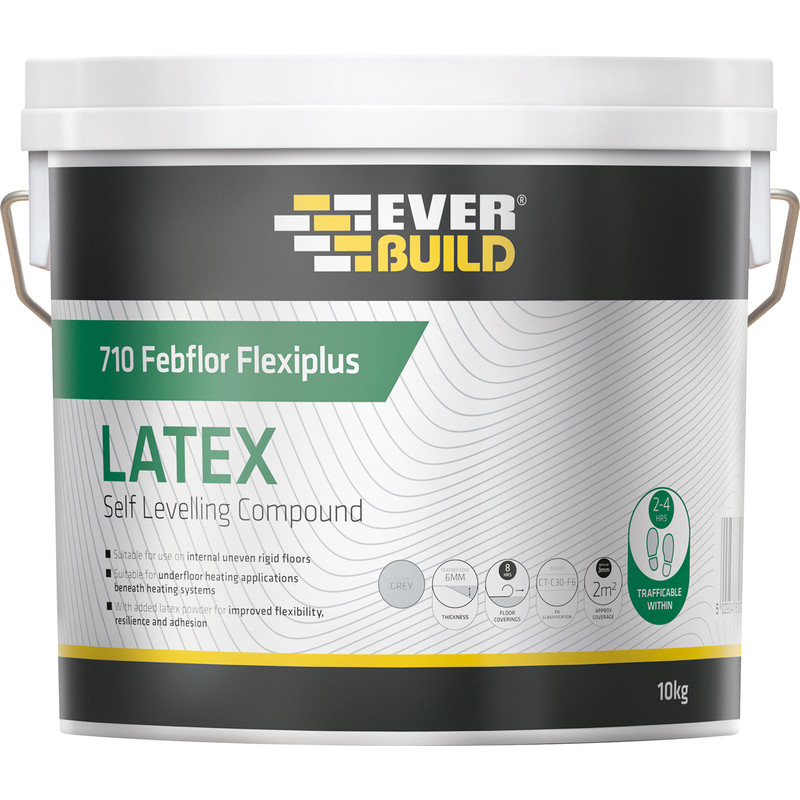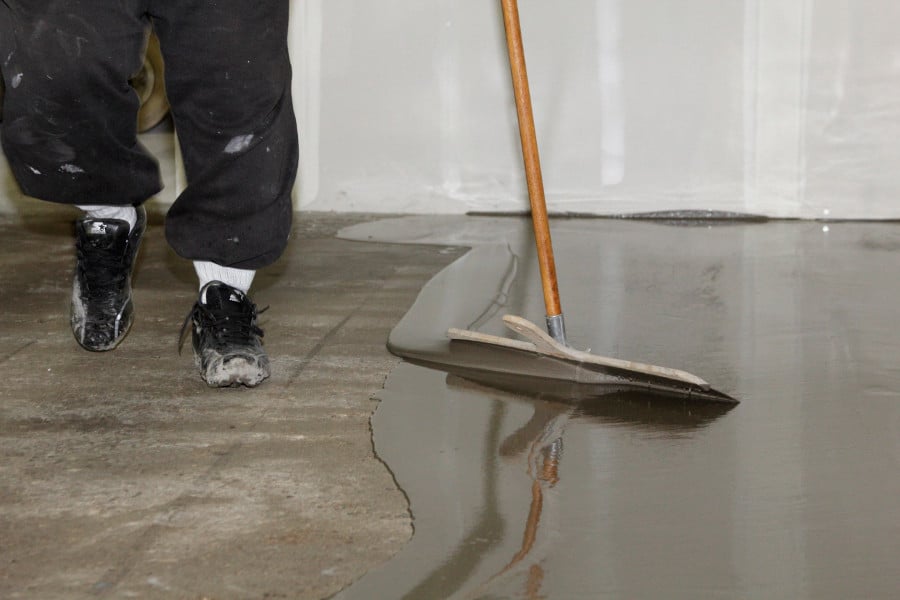Are you tired of uneven, cracked, or bumpy concrete floors? Imagine stepping into your home or business and feeling the smooth, consistent surface beneath your feet. The magic of self-leveling compound can transform your concrete floors into a beautiful and functional masterpiece. But with so many options on the market, how do you choose the best self-leveling compound for your needs?

Image: viewfloor.co
This comprehensive guide will walk you through everything you need to know about self-leveling compound. We’ll explore the different types, their applications, and factors to consider when picking the perfect compound for your project. By the end, you’ll have a firm grasp of this remarkable product and be confident in your choice.
What is Self-Leveling Compound?
Self-leveling compound, also known as self-leveling concrete or floor leveling compound, is a pre-mixed, free-flowing material designed to smooth and level uneven concrete floors. The compound, typically a cement-based mixture, is poured onto the existing concrete and self-distributes to create a uniform surface. This remarkable product saves you the hassle and expense of traditional concrete leveling techniques.
Types of Self-Leveling Compound
Self-leveling compounds come in various forms, each suited to different applications and desired finishes. Here are the most common types:
1. Cement-Based Self-Leveling Compound
Cement-based compounds are the most prevalent type. They offer excellent strength, durability, and affordability, making them ideal for a wide range of projects. These compounds are generally water-based and exhibit good adhesion to concrete substrates.

Image: www.linquip.com
2. Polymer-Modified Self-Leveling Compound
Polymer-modified compounds offer enhanced properties like increased flexibility, water resistance, and impact resistance. They are particularly beneficial for applications where the floor will experience heavy traffic or be exposed to moisture. While they tend to be more expensive than cement-based options, their superior performance justifies the cost in certain scenarios.
3. Epoxy Self-Leveling Compound
Epoxy compounds are known for their exceptional strength, chemical resistance, and durability. They are often used in commercial and industrial settings where the floor is subject to high levels of wear and tear, chemical spills, or heavy machinery.
4. Acrylic Self-Leveling Compound
Acrylic compounds are relatively thin and are primarily used for delicate leveling work, such as smoothing out minor imperfections. If a high-gloss finish is desired, acrylic compounds can also be employed.
Choosing the Right Self-Leveling Compound: Key Considerations
To select the most appropriate self-leveling compound for your project, you need to consider these essential factors:
1. Thickness Requirement
The thickness of the compound you choose depends on the severity of the unevenness in your concrete floor. For minor imperfections, a thin-set compound will suffice. However, if you need to level significant dips or bumps, a thicker compound is necessary.
2. Traffic Load
The anticipated traffic load on your floor is crucial. If the floor will experience high foot traffic or heavy machinery, a durable compound with increased compressive strength is essential.
3. Moisture Resistance
In areas prone to moisture, such as bathrooms, kitchens, or basements, a water-resistant compound is necessary to prevent moisture penetration and damage.
4. Chemical Resistance
If the floor will be exposed to chemicals, such as cleaning agents or solvents, choose a compound with appropriate chemical resistance. Epoxy compounds often excel in such environments.
5. Drying Time
The drying time of self-leveling compound varies depending on the type and thickness applied. It’s essential to select a compound with a drying time that suits your project timeline.
6. Substrate Compatibility
Ensure the compound you choose is compatible with your existing concrete substrate. Some compounds may require a primer or bonding agent for proper adhesion.
Application of Self-Leveling Compound: Step-by-Step Guide
Applying self-leveling compound effectively requires careful preparation and adherence to a step-by-step process:
1. Preparation
Thoroughly clean the concrete floor to remove dirt, debris, grease, and laitance (a powdery layer that forms on the surface of concrete). Cracks or large imperfections may need to be filled with a suitable filler before applying the self-leveling compound.
2. Mix the Compound
Follow the manufacturer’s instructions for mixing the compound. Typically, this involves adding water to the dry powder and mixing until a smooth, flowable consistency is achieved.
3. Pour and Spread
Pour the mixed compound onto the prepared floor and spread it using a trowel or squeegee. Allow the compound to self-level, ensuring it reaches the desired thickness.
4. Cure Time
After application, the compound will need to cure for a specific period before it can be walked on or subjected to further finishing. The manufacturer’s instructions will detail the necessary cure time.
5. Finish (Optional)
Once the compound has fully cured, you can apply a finish, such as a coating or paint, to enhance aesthetics, protection, or durability.
Benefits of Using Self-Leveling Compound
Choosing self-leveling compound for your concrete flooring project has numerous advantages:
1. Smooth and Level Surface
Self-leveling compound provides a smooth and level surface that is ideal for a variety of floor finishes, including tile, wood, and carpet.
2. Improved Aesthetics
A self-leveling compound can dramatically improve the appearance of your concrete floors, making them more aesthetically pleasing and vibrant.
3. Increased Durability
Self-leveling compound is a durable and long-lasting solution for concrete floors, providing resistance to wear and tear, moisture, and chemicals (depending on the type of compound).
4. Enhanced Functionality
A smooth and level concrete floor is easier to clean, making it more functional for both residential and commercial applications. It can also enhance the safety and accessibility of the space, reducing the risks of tripping or slipping.
5. Cost-Effective Solution
Although self-leveling compound may seem like a significant investment upfront, it can save you money in the long run by eliminating the need for costly floor replacement or extensive repairs.
Safety Precautions
When using self-leveling compound, prioritize safety by following these precautions:
1. Ventilation
Ensure adequate ventilation during mixing and application, as the compound may release fumes.
2. Protective Gear
Wear protective gear, including gloves, safety glasses, and masks, to prevent contact with the compound.
3. Follow Mixing Instructions
Adhere to the manufacturer’s mixing instructions for optimal performance and safety.
4. Proper Disposal
Dispose of the compound and packaging materials appropriately, adhering to local regulations.
Popular Brands of Self-Leveling Compound
The self-leveling compound market offers a wide range of brands, each with its unique features and qualities. Here are some of the most popular brands among contractors and homeowners:
1. Mapei
Mapei is a renowned manufacturer of construction chemicals, including a diverse selection of self-leveling compounds. They are known for their quality, durability, and innovation.
2. Ardex
Ardex is another trusted brand in the flooring industry, offering a vast portfolio of self-leveling compounds suitable for various applications. Their products are known for their superior performance and versatility.
3. Henry
Henry offers a variety of self-leveling compounds designed for different needs, including thin-set, mid-range, and thicker solutions. Their products are known for their ease of application and excellent bonding properties.
4. Custom Building Products
Custom Building Products is a leading manufacturer of flooring materials, including self-leveling compounds. Their products are recognized for their quality, reliability, and ease of use.
Best Self Leveling Compound For Concrete Floors
Conclusion
Self-leveling compound offers a powerful solution for transforming uneven concrete floors into smooth, level, and aesthetically pleasing surfaces. As you’ve learned, choosing the right type of compound involves considering the project’s needs, traffic load, moisture resistance, and chemical resistance. By understanding the application process and safety precautions, you can achieve professional-looking results. Now that you have a comprehensive understanding of self-leveling compounds, embark on your next flooring project with confidence and watch your concrete floors take on a whole new life.





